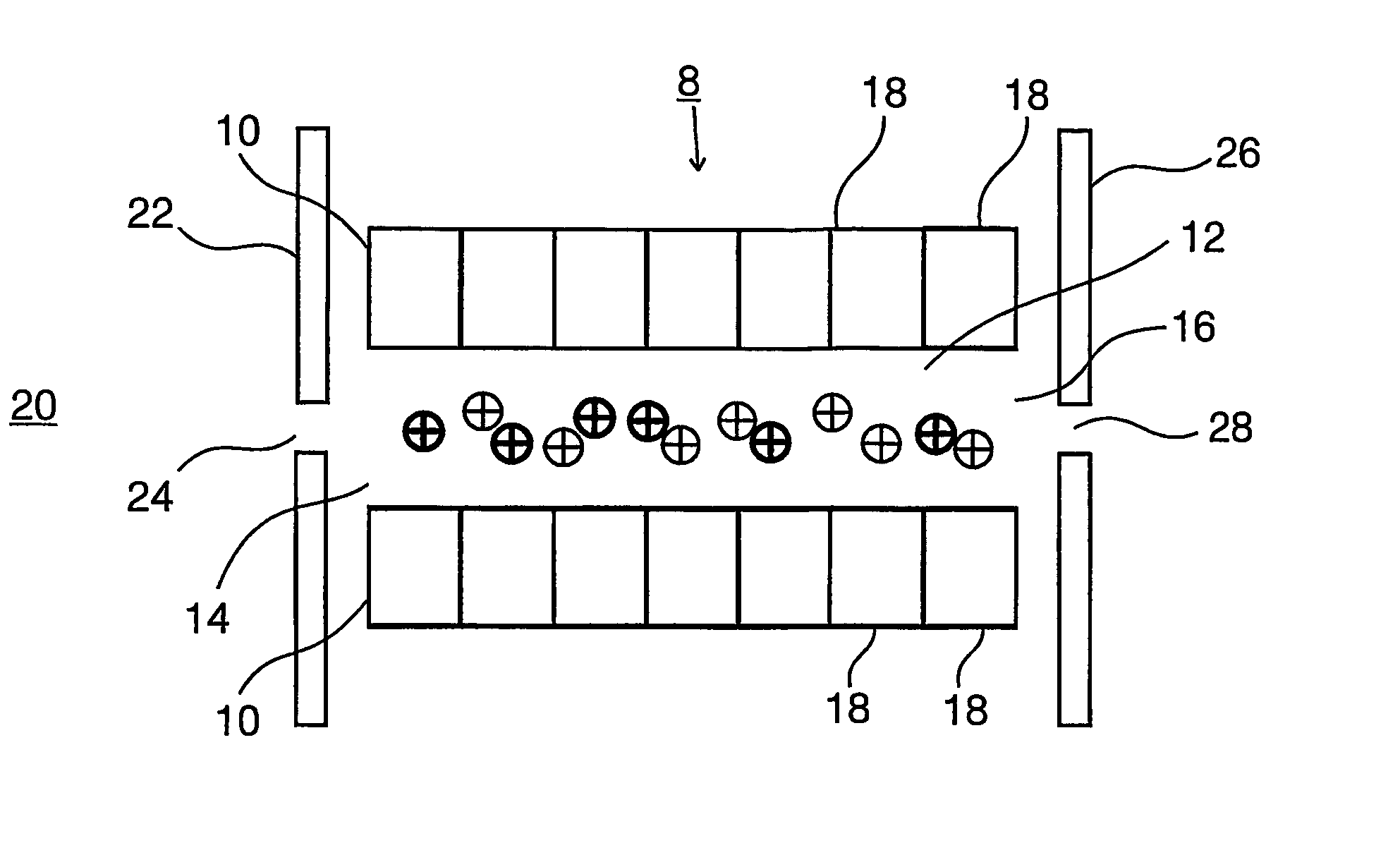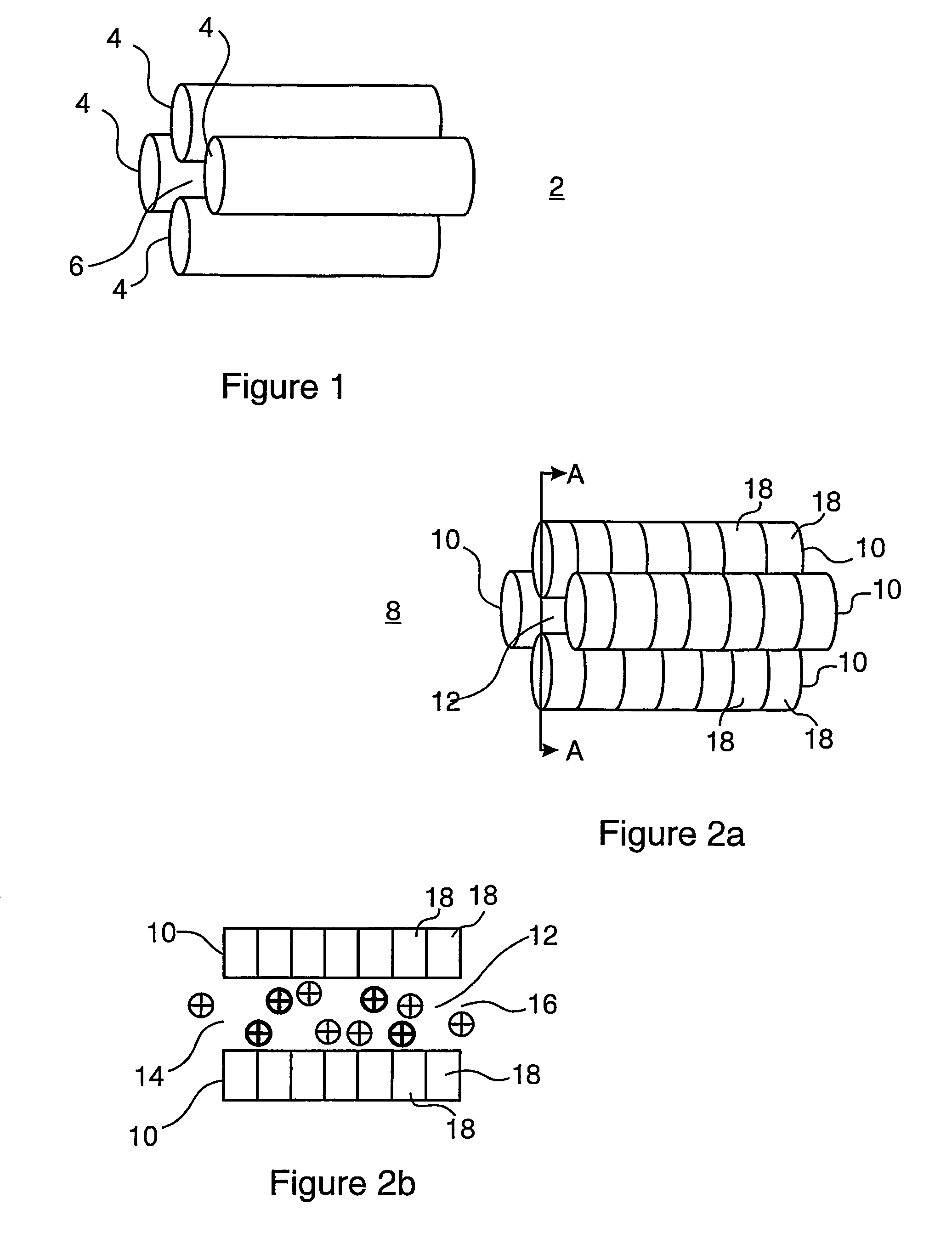FAIMS apparatus and method for separating ions in the gas phase
a gas phase and apparatus technology, applied in the field of high-speed separation methods and apparatuses, can solve the problems of difficult production of asymmetric square waveforms, failure of all efforts to use these and other related rf devices at 760 torr, and inability to mov
- Summary
- Abstract
- Description
- Claims
- Application Information
AI Technical Summary
Problems solved by technology
Method used
Image
Examples
experiment # 1
[0085]Experiment #1 is performed using an instrument mechanically identical to a triple quadrupole system where additionally the collision quadrupole is connected to electronics that permit a phase shift of the sinusoidal waves used to form the applied waveform. All conventional tandem MS experiments are performed with the collision quadrupole operated in rf-only mode with a symmetrical waveform. Experiment #1 requires filling the collision cell with gas to a pressure that is suitable for operation in FAIMS mode, and is sufficiently low pressure that conventional rf-only mode will also function, with collisional cooling. This high pressure will not necessarily correspond to pressures used in collision-induced-dissociation (CID) experiments. It is likely that performance of the rf-only mode at this pressure will also be less-than-optimum. In this experiment the user selects several parameters including the waveform voltage for operation in FAIMS mode, the phase angle for formation of...
experiment # 2
[0087]Experiment #2 is performed on an instrument with segmented quadrupole rods in the collision cell. This experiment is similar to that of Experiment #1, but the segments of the quadrupole are biased to pull the ions through the quadrupole. At the high gas pressures necessary for operation in FAIMS mode, the translational motion of the ions is retarded by the bath gas, and the transmission of ions could be very low. The longitudinal electric field is generated by biasing the segments (superimposed on rf voltages, dc voltages for FAIMS operation, and the asymmetric waveform) with voltages in a series of decreasing potentials (e.g. decreasing for positive ions, increasing for negative ions). This longitudinal field carries the ions along the length of the assembly, and they are transmitted out of the collision cell into the final analyzer (quadrupole, TOF, FTMS etc. etc.).
[0088]Experiment #3 can be performed on any of the instruments used for experiments #1 and #2. This experiment ...
experiment # 5
[0090]Experiment #5 is performed on an instrument that differs substantially from those described above. A conventional collision cell has limitations. The primary weakness of the conventional high pressure cell is that the ions from a low pressure region (including the mass analyzer directly in front of the cell) are inefficiently transmitted into a region of high gas pressure because of the outpouring of gas through the entrance orifice of the cell. This leaking flow of gas cannot be avoided in a high pressure cell that is located totally within the confines of a low pressure mass spectrometer chamber. At elevated cell pressures this transport of ions into the cell becomes more difficult and less efficient. This problem is overcome in Experiment #5, by locating this special combined rf-only and FAIMS cell directly behind the entrance orifice of the mass spectrometer. The flow of gas into the vacuum chamber carries the ions into this cell, and the efficiency of ion transport into t...
PUM
| Property | Measurement | Unit |
|---|---|---|
| gas pressure | aaaaa | aaaaa |
| gas pressure | aaaaa | aaaaa |
| gas pressure | aaaaa | aaaaa |
Abstract
Description
Claims
Application Information
 Login to View More
Login to View More - R&D
- Intellectual Property
- Life Sciences
- Materials
- Tech Scout
- Unparalleled Data Quality
- Higher Quality Content
- 60% Fewer Hallucinations
Browse by: Latest US Patents, China's latest patents, Technical Efficacy Thesaurus, Application Domain, Technology Topic, Popular Technical Reports.
© 2025 PatSnap. All rights reserved.Legal|Privacy policy|Modern Slavery Act Transparency Statement|Sitemap|About US| Contact US: help@patsnap.com



